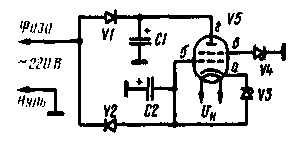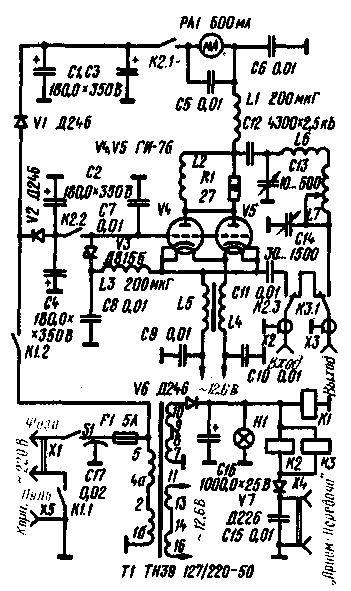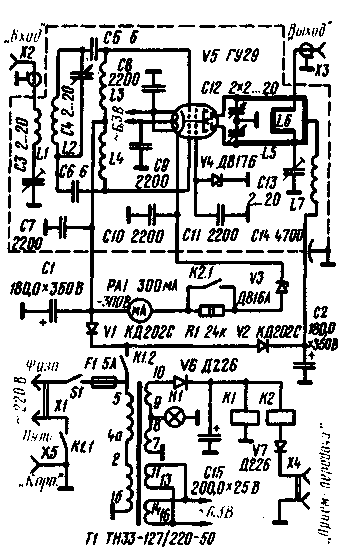
|
|
ENCYCLOPEDIA OF RADIO ELECTRONICS AND ELECTRICAL ENGINEERING Transformerless power supply in the power amplifier. Encyclopedia of radio electronics and electrical engineering
Encyclopedia of radio electronics and electrical engineering / RF power amplifiers In amateur radio sports equipment, transformerless ones are sometimes used [1]. or rather, not containing powerful high-voltage transformers, power supplies. The advantages of such power supplies are obvious; they can significantly reduce the size and weight of the transmitting equipment. The use of transformerless power supply is especially effective in tube power amplifiers of the 1st category, when very light and very compact power amplifiers can be created on the basis of powerful modern semiconductor diodes and small-sized electrolytic capacitors. Such amplifiers are convenient for operation both in stationary conditions and in radio expeditions. The transformerless power supplies discussed below are designed to operate with a single-phase 220 V AC network, one of the wires of which is zero. It should be immediately emphasized that the operation of equipment with transformerless power supply is possible if and only if the radio station has reliable electrical grounding. The presence of a galvanic connection between the power source and the AC network requires the use of not only good grounding, but also a special starting device that prevents the equipment from turning on if the transformerless power supply is incorrectly connected to the network. We must not forget that such protection only works when grounding is connected, which must be ensured without fail before plugging the power hose into a socket. In general, the manufacture of structures with transformerless power supply can be recommended to radio amateurs who already have experience in the manufacture and operation of communication equipment. Typical modes of powerful cascades on common lamps GU-19, GU-29, GS-90, GI-7B, etc. are provided by a power source, the circuit of which is shown in fig. one.
It consists of two half-wave rectifiers (VI, C1 and V2, C2) operating directly from the mains with output voltages of +300 V and -300 V (relative to the case). The operating mode of the V5 lamp is determined by the zener diodes V3 and V4. The voltages at the electrodes of the V5 lamp (relative to the cathode) are determined as follows:
where Uc1 - voltage on the control grid; Uc2 - screen grid voltage; Ua - anode voltage. When choosing zener diodes, it must be taken into account that the maximum stabilization current of the zener diode V3 is not less than the peak value of the anode current, and V4 is the current of the screen grid. The required range of stabilization voltages and currents is provided by diodes D815A-D817G. Since the cathode of the V5 lamp is at a potential of about -300 V relative to the body, the windings of the filament transformer must be well insulated from the body. The high dynamic characteristics of a transformerless power supply are due to the fact that there are no transformers and filter chokes in the rectifiers, which have a significant inductance. The static characteristic is determined by the capacitors C1 and C2. To ensure that the output voltage ripple level is less than 0,05%, which is necessary for the operation of a linear power amplifier [2], the capacitances of these capacitors (in microfarads) must correspond to the numerical value of the maximum power (expressed in watts) consumed from the power source. Capacitors (filter and blocking) must be rated for a voltage of at least 350 V. Capacitors C1, C2 can be small - K50-7, K50-12. Rectifier diodes V1 and V2 must be rated for a reverse voltage of at least 350 V and a peak current greater than the charging current of capacitors Cl and C2 (typically 2 to 5 A). Diodes D246, KD202K - KD202S satisfy this condition. HF radio power amplifier category 1 On fig. Figure 2 shows a diagram of an output linear amplifier made on two GI-7B metal-ceramic triodes connected according to a grounded grid circuit. The transformerless power supply for the amplifier is designed for a peak load of about 360 watts, which allows 200 watts of power (average) to be supplied in single-sideband signal amplification mode. Power gain - 15 dB.
The lamp mode V4, V5 is designed so that at a mains voltage of 220 V Uc1 = -7V, Ua = +600 V, the initial anode current of both lamps connected in parallel is 40 mA, the maximum anode current is 600 mA. With a mains instability of ±20 V, the amplifier maintains good linearity. The resistance of the anode load of the cascade is 1 kOhm. The use of two lamps in the amplifier. connected in parallel is explained by the need to obtain a large anode current at a relatively low anode voltage. The average power dissipated at the anode of each lamp does not exceed 50 W, as a result of which the lamps operate reliably even without forced air cooling. The starting device is made on the electromagnetic relay K1, the contacts K 1.1 and K1.2 of which connect the neutral wire of the network to the case and supply the mains voltage to the rectifiers on the diodes V1 and V2. When the toggle switch S1 is on, the starting device will not work, and therefore, the power source will be disconnected from the network if the device case is not grounded or the device case is grounded, but the "phase" contact of the X1 mains plug is connected to the neutral wire of the network. Thus, when the transceiver is connected to the network, it is necessary to connect the ground to the case, turn on the S1 toggle switch and find the position of the X1 plug in the mains socket, at which the starting device is triggered. Relays K2 and K3 switch the corresponding circuits during the transition from reception to transmission. When working for reception, the supply voltages (except for the glow) are removed from the lamps, and the transceiver is connected to the antenna through the X3 connector. Capacitors C1 and C3-K50-12, C2 and C4 - K50-7, C6 - C10 - KSO for an operating voltage of 600 V. Chokes L1 and L3 must be rated for a current of 600 mA, L4, L5 - for 4 A. The latter are wound on a high-frequency ferrite ring, for example 50VCh3, into two wires (20 turns of MGSHV with a cross section of 1,5 sq. mm). Coil L2 is wound around resistor R1. It contains 3 turns of silver-plated wire with a diameter of 1 mm. As the L7 coil, a variometer from the RSB-5 radio station is used. Coil L6 - frameless (winding diameter 40 mm), contains 2 turns of silver-plated wire with a diameter of 2,5 mm. Relays K1 and K2 - 8D-54, passport OAB.393.054, K3 - high-frequency from the RSB-5 radio station. Transformer T1 - TN-39-127 / 220-50. With the ratings of capacitors C1 - C4 indicated in the diagram, the anode voltage drop (compared to the initial mode) does not exceed 30 V at a current of 600 mA. 144 MHz power amplifier On fig. 3 shows a diagram of a linear amplifier operating in the range of 144 ... 146 MHz, made on a GU-29 lamp. The power gain is about 20 dB, which makes it possible to use a transistor VHF transmitter as an exciter.
The operating mode of the GU-29 lamp is as follows: Uc1=-22 V. Uc2=+225 V, Ua=+580 V, the maximum anode current is 250 mA. With a mains instability of ±15 V, the lamp mode changes slightly, and the linearity of the power amplifier does not deteriorate. Relay K1 (RES-6, passport RF0.452.106) - starting, K2 (RES-10, passport RS4.524.305) switches the cathode circuit of the V5 lamp. The latter is closed during reception. Inductors L3, L4, L7 with an inductance of 10 μH should be rated for a current of 0,3 A. Coil L2 is frameless, contains 5 turns of silver-plated wire with a diameter of 1,5 mm, the winding pitch is 3 mm. The outer diameter of the coil is 12 mm. The communication coil L1 contains 1,5 turns of silver-plated wire with a diameter of 1 mm, the winding pitch is 3 mm, the outer diameter of the coil is 16 mm. Wrap it over L2. Coil L5 is made of silver-plated wire with a diameter of 2 mm in the form of a loop with dimensions of 80x35 mm. The communication loop L6 with dimensions of 40x35 mm is made of a silver-plated wire with a diameter of 1,5 mm. It is placed at a distance of 6 mm from L5. Capacitors C1, C2-K50-7 or K50-12 for an operating voltage of 350 V, C7-C11-KSO for an operating voltage of 500 V. C3, C4 and C13 - CPV. The differential capacitor C12 is composed of two CPVs, the rotors of which are fixed on the same axis. Incandescent transformer T1 - TN33-127 / 220-50 or any other with separate windings for voltages of 6.3 and 12,6 V. When establishing the amplifier, the capacitor C3 regulates the connection with the exciter, C13 - the connection with the antenna, the capacitor C4 is tuned to the operating frequency of the grid circuit, and C12 - the anode. Literature
Author: G. Ivanov (UA3AFX, U0AFX); Publication: N. Bolshakov, rf.atnn.ru
Artificial leather for touch emulation
15.04.2024 Petgugu Global cat litter
15.04.2024 The attractiveness of caring men
14.04.2024
▪ Artificial tree purifies water and squeezes it out of the air
▪ section of the Electrician website. Article selection ▪ article by Denis Diderot. Famous aphorisms ▪ article Why do soldiers salute? Detailed answer ▪ article Dioscorea Caucasian. Legends, cultivation, methods of application ▪ article Cigarette on the edge of a glass. Focus secret
Home page | Library | Articles | Website map | Site Reviews www.diagram.com.ua |






 Arabic
Arabic Bengali
Bengali Chinese
Chinese English
English French
French German
German Hebrew
Hebrew Hindi
Hindi Italian
Italian Japanese
Japanese Korean
Korean Malay
Malay Polish
Polish Portuguese
Portuguese Spanish
Spanish Turkish
Turkish Ukrainian
Ukrainian Vietnamese
Vietnamese




 Leave your comment on this article:
Leave your comment on this article: